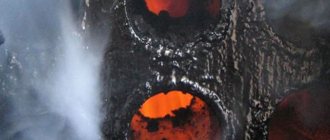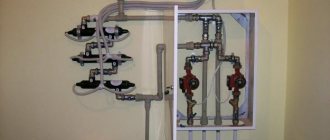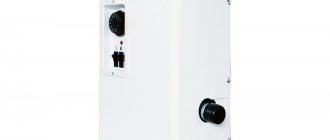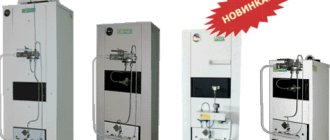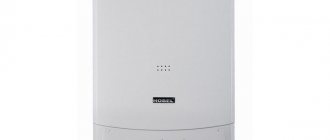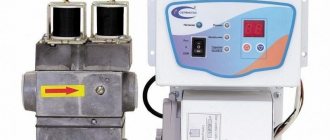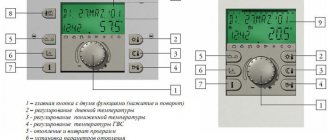Home / Commissioning
Back
Published: 06/01/2019
Reading time: 3 min
0
1633
Before choosing and purchasing, it is worth making a correct calculation of the efficiency of the boiler and clarifying all its parameters and factors that will affect its operation and the amount of heat generated.
- 1 What is boiler efficiency and what processes affect its value
- 2 How to calculate efficiency
- 3 How to increase the efficiency of a gas boiler
- 4 Gas boilers with the highest efficiency
Gross efficiency and net efficiency
Not all the heat generated during fuel combustion is used to heat the coolant; a certain part is spent on the boiler unit’s own needs: turbine, fan or smoke exhauster, circulation pump, operation of automation and electronic display, operation of the electric drive (as you already understand, all types of energy received are used in the calculation , including electricity, if the boiler is volatile).
Taking this into account, it is customary to divide the boiler efficiency by the generated heat ( gross efficiency ) and the released heat ( net efficiency ).
This classification allows us to highlight the degree of technical perfection of the boiler - gross efficiency or efficiency of fuel and electricity consumption - net efficiency.
How to calculate the efficiency of a heating boiler
Values can be calculated in several ways. In European countries, it is customary to calculate the efficiency of a heating boiler based on the temperature of the exhaust gases (direct balance method), that is, knowing the difference between the ambient temperature and the actual temperature of the gases exiting through the chimney. The formula is quite simple:
ηbr = (Q1/Qir) 100% , where
- ηbr (read “this”) – boiler efficiency “gross”;
- Q1 (MJ/kg) – the amount of heat that was accumulated, i.e. used for heating the house.
- Qir (MJ/kg) – the total amount of heat released during fuel combustion;
For example, if Q1 = 19 MJ/kg, Qir = 22 MJ/kg, then gross efficiency = (19/22)*100 = 86.3%. All measurements are carried out at an already established, standard boiler operating mode.
The direct balance method does not take into account the heat loss of the boiler itself, underburning of fuel, deviations in operation and other features, so a fundamentally different, more accurate calculation method was invented - the “reverse balance method”. The equation used is:
ηbr = 100 – (q2 + q3 + q4 + q5 + q6) , where
- q2 – heat loss with exhaust gases;
- q3 – heat loss due to chemical underburning of combustible gases (applicable to gas boilers);
- q4 – loss of thermal energy with mechanical underburning;
- q5 – heat loss from external cooling (through the heat exchanger and housing);
- q6 – heat loss with physical heat of slag removed from the furnace.
Net efficiency of the heating boiler according to the reverse balance method:
ηnet = ηbr - Qs.n , where
- Qс.н – total consumption of thermal and electrical energy for own needs in % expression.
The actual efficiency will almost always differ from that declared by the manufacturer, since it depends on the correct installation of the boiler and heating system, smoke removal system, quality of power supply, etc. It is measured, accordingly, already on the spot.
Installing radiators for maximum efficiency
Radiators are installed in areas where heat loss in the room is most significant, for example, next to windows. To achieve maximum efficiency, the window sill should cover about 2/3 of the upper plane of the battery and be approximately 10 cm from its surface. The recommended distance between the radiator and the floor is 12 cm. The rear surface of the battery should be separated from the wall by 2 cm. This will create proper natural convection , in which a certain amount of heat is spent on heating the wall and blocking heat loss in the room, and most of the energy is directed to heating.
Safety measures for increasing efficiency
Just 20-30 years ago, the price of energy resources in the post-Soviet space was low, so no one paid attention to such a parameter as efficiency. After all, performance could decide everything. But when gas began to rise in price, and modern technologies were still unavailable, craftsmen began to modernize gas boilers in order to increase efficiency, using accessible methods.
When performing any work with gas equipment, it is necessary to observe safety measures and possess special skills and tools. And also you should not use methods prohibited by law to increase efficiency.
For example, attaching copper and aluminum plates to heat exchangers to improve heat transfer. Heat loss from structural elements of heating devices was reduced by welding third-party elements. The automation and heat exchangers were changed. Other similar methods were also used. Efficiency increased, but the state and the gas service did not react to the “creativity” of the craftsmen.
Now everything is different and relevant laws prohibit changing the design of gas boilers, which must be certified, like all their individual elements. As a result, it is impossible to increase efficiency by replacing mechanical, electrical and other components of heating devices with third-party ones.
Violation of these requirements may result in:
- Administrative responsibility. If Gorgaz employees detect tampering with the boiler design, but there were no incidents, they will have to pay a fine of 10-15 thousand rubles. This is indicated by Article 7.19 of the Administrative Code. In severe cases, the gas service has the right to even terminate the service contract and stop supplying fuel.
- Criminal liability. As evidenced by Federal Law No. 229-FZ of July 29, 2018 “On amendments to Article 215.3 of the Criminal Code of the Russian Federation and Articles 150 and 151 of the Code of Criminal Procedure of the Russian Federation.” These standards will come into force if design changes lead to serious consequences.
That is, it’s not worth risking people’s lives to increase the efficiency of the boiler by a few percent.
What determines the thermal efficiency of boiler units?
The operating principle of a classic floor-mounted gas atmosphere.
The efficiency of heating boilers is not equal at any power; there is a proportional dependence on the load: an increase in the thermal load (the amount of fuel burned) also increases heat loss through the body or chimney. Likewise, operation at minimum power does not always ensure complete combustion of fuel, which leads to a decrease in efficiency.
For example, the service instructions for gas boilers Protherm Wolf KSO with a power of 12.5 kW and 16.0 kW indicate that when operating at maximum power (12.8 kW and 16.3 kW, respectively), the efficiency is 92.5%, while time when operating with a minimum load (4.5 kW and 5.8 kW) - will decrease and amount to only 78.4%.
This is one of the main reasons why you should take a conscious approach to choosing the power of the boiler unit. The most optimal operation in most models is achieved at a load in the range of 60-90% of maximum power.
Otherwise, the efficiency depends solely on the technological excellence of the model, aimed at reducing the above-described q2-6 (reducing the temperature of exhaust gases, efficient combustion of fuel, modulating burners, thermal insulation, etc.), as well as on the quality of maintenance and operation of the boiler unit. Cleanliness of the coolant, regular cleaning and flushing - all this over time seriously affects the efficiency.
How to choose a room thermostat and save up to 30% per month on heating
What should an energy efficient boiler be like?
The characteristics specified in the documents and rich practical experience show that imported boilers have the highest efficiency. European manufacturers pay special attention to the use of energy-saving technologies, which allows them to get the most out of their equipment. Let’s make a “portrait” of an ideal gas boiler:
- modulation burner - automatically adapts to the operating mode of the system, minimizing the percentage of underburning;
- heating the coolant no more than 70 degrees, exhaust gases - up to 110 degrees, which ensures an optimal balance of efficiency, it is desirable to have a condensation heat exchanger;
- coaxial chimney - a closed combustion chamber requires the equipment to have a pipe-in-pipe channel for removing combustion products, which allows heating the air flow from the street;
- recirculation system - allows you to use the heat of exhaust gases to heat the room.
Of course, such an ideal boiler does not exist, but a list of the best technical solutions will help you choose a worthy model.
Values of modern boilers depending on the type of fuel
| Photo | Type of boiler depending on the fuel burned | Average efficiency, % |
| Gas | ||
| — Convection | 87-94 | |
| — Condensation | 104-116* | |
| Solid fuel | ||
| — Wood-burning | 75-87 | |
| — Coal | 80-88 | |
| — Pellet | 80-92 | |
| Liquid fuel | ||
| — On diesel fuel | 86-91 | |
| — On fuel oil | 85-88 | |
| Electric heating elements | 99-99,5 |
*From a physics point of view, efficiency cannot exceed 100%: it is impossible to obtain more thermal energy than is released when burning fuel. However, it all depends on how you count. There are two definitions:
- lower calorific value - the heat obtained during the combustion of fuel, when the combustion products are simply removed through the chimney;
- higher calorific value - heat, including the energy contained in water vapor - one of the products of combustion of flammable gases.
Gas condensing boilers additionally accumulate the thermal energy of condensate formed from gas combustion products and deposited on an additional heat exchanger. Thus, a significant part of the heat does not “fly out into the chimney”, and the temperature of the exhaust gases is almost equal to atmospheric.
Construction of a simple condensing single-circuit gas boiler.
According to current standards, both in Russia and in Europe, the efficiency of heating boilers is calculated based on the lowest specific calorific value, so taking into account the additional heat extracted from the condensate leads to values of more than 100%. When calculated based on the higher calorific value, the efficiency of condensing gas boilers is 96-98%, depending on the model and type of installation: wall-mounted boilers usually have higher efficiency than floor-standing boilers (this applies to all gas boilers).
Also from the table you can see that the average efficiency of solid fuel boilers also differs depending on the fuel used, this is due to the degree of fuel combustion, its heat transfer, combustion temperature and heat loss with physical heat of slag removed from the combustion chamber. Even the same solid fuel boiler can produce different efficiencies when operating on different types of fuel.
Construction of the main components of a condensing boiler
From a structural point of view, a condensing boiler is not very different, but still differs from a conventional gas boiler.
Its main elements are:
• combustion chamber equipped with a burner, fuel supply system and fan for air injection;
• primary heat exchanger;
• chamber for additional cooling of the vapor-gas mixture to a temperature as close as possible to 56-57°C;
• heat exchanger No. 2 (condensation heat exchanger);
• tank for collecting condensate;
• chimney for removing cold flue gases;
• a pump that circulates water in the system.
In the primary heat exchanger connected to the combustion chamber, the released gases are cooled to a temperature significantly above the dew point (in fact, this is what ordinary convection gas boilers look like). Then the smoke mixture is forced to the condensation heat exchanger, where it is further cooled to a temperature below the dew point, that is, 56°C. In this case, water vapor condenses on the walls of the heat exchanger, giving up the last of its energy. The condensate is collected in a special tank, from where it flows down the drain pipe into the sewer.
Water, which acts as a coolant, moves in the direction opposite to the movement of the vapor-gas mixture. Cold water (heating system return fluid) is preheated in the condensing heat exchanger. It then enters the primary heat exchanger where it is heated to a higher temperature set by the user.
Condensate is not pure water, but a mixture of dilute inorganic acids. Their concentration is small, but taking into account the fact that the temperature in the system is always elevated, condensate can be considered an aggressive liquid. That is why in the production of such boilers (and, first of all, the corresponding heat exchangers), acid-resistant materials are used - stainless steel or silumin (aluminum-silicon alloy). The heat exchanger, as a rule, is made cast, since the welds are a vulnerable point - this is where the process of corrosive destruction of the material first begins.
The steam must condense on the condensation heat exchanger. Everything that passes further into the chimney, on the one hand, is lost for heating, and on the other, has a destructive effect on the chimney material. It is for this last reason that the chimney is made of acid-resistant stainless steel or plastic, and its horizontal sections are given a slight slope so that the water formed by the condensation of small amounts of steam that still enter the chimney is drained back into the boiler. The flue gases leaving the condenser are very cooled, and everything that did not condense in the boiler will certainly do so in the chimney.
At different times of the day, different amounts of heat are required from the heating boiler, which can be adjusted using a burner. For a condensing boiler, it can be either modulated - with the ability to smoothly change the power during operation, or unmodeled - with a fixed power. In the latter case, the boiler adapts to the requirements of its owner, who can turn on the burner at different frequencies. Most modern boilers intended for heating private homes are equipped with simulated burners.
The main advantages of a condensing boiler
The list of advantages of a condensing boiler is impressive, which ultimately explains the growing popularity of this type of heating equipment:
• Fuel savings compared to a conventional convection boiler can reach 35%;
• The reduction in harmful emissions when switching from traditional gas models to condensing ones is estimated at an average of 70%;
• The low temperature of the exhaust gases makes it possible to install plastic chimneys, which are much cheaper than classic steel ones;
• Low noise level does not create discomfort for people living in the house.
Customer reviews for products in the category Condensing boilers
anonymous review
(review received from Yandex.Market) Review on: CLAS EVO SYSTEM 28 FF
Advantages: Excellent single-circuit boiler, with a three-way valve. Consumption per house is 180 square meters per month, quite a good 500 cubic meters of gas, at a maximum temperature of 50-60 degrees, plus an indirect boiler . Thermos house (frame). Outdoors from +5 to -12 More often + than minus.
Disadvantages: There are no complaints about the boiler, it does its job
Comment: The master installer did not understand what he was doing at all, so they redid the indirect heating boiler 3 times, after which it began to heat up quickly and efficiently. Everything is written in the book for the boiler, but Vanya can’t read Russian, and takes the instructions last)))
Milovanov Evgeniy
(review received from Yandex.Market) Review on: GENUS PREMIUM EVO 24
Advantages: Low gas consumption, easy installation, easy to use
Flaws:
Comment: I overwintered the first winter with this boiler. A house of 170 sq.m. with heated floors and electronics; for the entire heating season, gas consumption amounted to 2700 cubic meters in 6 months. The house was warm and comfortable. I am very pleased with the performance of this boiler. There are no complaints, the build quality is good. I advise you to take it if possible
Shepherd Vladimir
(review received from Yandex.Market) Review on: GENUS PREMIUM EVO SYSTEM 24
Advantages: Excellent boiler. trouble-free, perfectly handles power surges in SNT. There are no complaints about the electrical part, nor about the technical part.
Disadvantages: Not silent. At night, in absolute silence in a wooden house on the second floor, you can hear the switch on in the toilet on the first floor. The presence of a stupid electronic recharge function. since it doesn’t refuel itself but asks to press a button - I can open the faucet myself if anything happens, but when, after the system froze, I began to leak water from the batteries into the hot water supply through the water supply, I had to turn it off.
Comment: I have an Ariston GENUS PREMIUM 24. It seems to be the same thing. In operation for 5 years. I operate on propane-butane, I transferred it myself using a nozzle (Such a plug is inserted into the gas supply tube) and adjusted it using a TORX screwdriver (The most fun part, since adjusting the hydraulic level did not give any results, and it turned out to be easier to start it by ear.). In the first half of a year of operation, my Stub burned out from a power surge, which I installed after reading horror stories about dying motherboards (By the way, a friend of Bosch’s board actually burned out 2 times ), and later the Boiler was powered from a simple socket with low voltage, unrealistic surges and other goodies of life in SNT - Electrically, I’m alive and well. Survived 3 frosts (gas ran out) during one of them the inlet block ruptured, although all the drain holes were open (Inside there are two plastic blocks into which all the pipes, a heat exchanger, a pump, an expansion tank, etc. are connected) There is a make-up valve and There is still water in it, even if everything is drained according to the rules. If you want to drain and freeze, you need to unscrew it and blow it out. After replacing the unit yourself, water from the heating system leaks into the hot water through the make-up system - I had to plug the channel inside the unit (I considered it pointless to order an absolutely useless make-up valve). Now I’m going to take the same model to my parents’ house.
In operation for 5 years. I operate on propane-butane, I transferred it myself using a nozzle (Such a plug is inserted into the gas supply tube) and adjusted it using a TORX screwdriver (The most fun part, since adjusting the hydraulic level did not give any results, and it turned out to be easier to start it by ear.). In the first half of a year of operation, my Stub burned out from a power surge, which I installed after reading horror stories about dying motherboards (By the way, a friend of Bosch’s board actually burned out 2 times ), and later the Boiler was powered from a simple socket with low voltage, unrealistic surges and other goodies of life in SNT - Electrically, I’m alive and well. Survived 3 frosts (gas ran out) during one of them the inlet block ruptured, although all the drain holes were open (Inside there are two plastic blocks into which all the pipes, a heat exchanger, a pump, an expansion tank, etc. are connected) There is a make-up valve and There is still water in it, even if everything is drained according to the rules. If you want to drain and freeze, you need to unscrew it and blow it out. After replacing the unit yourself, water from the heating system leaks into the hot water through the make-up system - I had to plug the channel inside the unit (I considered it pointless to order an absolutely useless make-up valve). Now I’m going to take the same model to my parents’ house.
Gennady
(review received on our website) Review for: LUNA Duo-tec+ 1.24
Advantages: excellent work.
Disadvantages: not yet identified.
Comment: I ordered a gas boiler. Received through a transport company. Thank you! The team works quickly.
How to increase the efficiency of a gas boiler
It is almost impossible to increase the efficiency of fuel combustion by interfering with the technical structure of the boiler; it will not be possible to install the same layer of thermal insulation due to the banal failure of the manufacturer to provide a place for it. In addition, doing this yourself is prohibited. Nevertheless, there are ways to increase the efficiency of a gas boiler, especially if it is an imperfect old-style model:
- Ready-made economizer for chimney – replaces a certain section of the chimney and is designed to accumulate heat from gases exhausted through the chimney (some kind of imitation of condensing boilers). However, it is necessary to accurately calculate the parameters of the economizer and the requirements for the chimney in order to maintain the necessary draft and prevent reverse draft, for example, in strong winds. The issue price is 1,700-2,500 rubles.
Sandwich mesh economizer for chimney pipe. - A homemade economizer is almost identical to the finished products described above. We have already described how to make an effective economizer in one of the previous articles.
- Cleaning the boiler and flushing the heat exchanger are regular maintenance measures that are meaningless for new boiler units, but extremely effective for those that have been in use for at least several seasons. The fact is that during operation, scale and other salt deposits form inside the heat exchanger, and the external fins of the heat exchanger, burners and igniter become clogged. All this leads to an increase in gas consumption, a decrease in heating output, and, accordingly, a decrease in efficiency (often up to 20-30%). We have also already discussed how and how often it is necessary to clean a gas boiler.
- Gas filter - it is installed in front of the shut-off valve of the gas main and is designed to clean the gas from debris and impurities that are sometimes found in the composition. This not only helps reduce soot formation, but also, by improving the quality of the fuel, slightly reduces heat loss during underburning.
The remaining methods involve proper commissioning, which is carried out once, when the boiler is first started, exclusively by specialists. With correct initial settings, the efficiency guaranteed by the manufacturer is ensured. It is important to understand that it is impossible to increase this indicator by interfering with the technical structure of the boiler itself, and even more so, it is not safe.
Instructions BoilersEnergy-saving technologies

